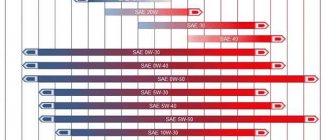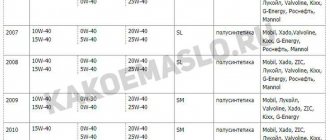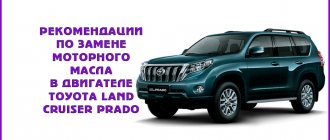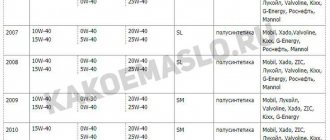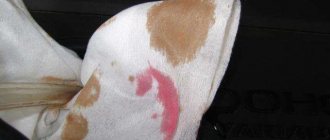Hello, dear readers! Today we are talking about the popular Toyota 5W40 motor oil - how to distinguish a fake.
This is one of the popular lubricants on the Russian, European and US markets. Because of this, scammers appeared. They make money on the trust and inattention of customers, as well as on the reputation of the manufacturer.
It is possible to identify fake Toyota 5W40 oil. It's not that difficult. You need to know where and what to look at.
The original lubricant is produced by ExxonMobil Corporation from the USA. The composition is aimed at Toyota cars, as well as models from other manufacturers. The production itself is carried out in the European Union countries. Mostly Italy is found on the Russian market.
You can understand that this is a fake Toyota 5W40 based on several signs.
Description, composition and properties of the product
Toyota 5w40 oil is a specialized lubricant for gasoline and diesel engines of Toyota vehicles.
The product is also excellent for engines of other car models, subject to the requirements and tolerances stated by the manufacturer. The lubricant belongs to the synthetic category and is highly resistant to oxidation and aging. Motor oil is able to withstand high loads and temperatures under extreme driving conditions and not freeze at subzero temperatures in winter. According to the SAE classification, the temperature range of the lubricant’s performance is from -300C to +450C.
Automotive oil contains a balanced package of additives. Detergent and detergent additives protect the power unit from the formation of deposits and loss of thermal conductivity. Anti-friction and anti-corrosion agents reduce wear and increase engine life. With timely replacement and systematic use, technical fluid can provide fuel savings of up to 5%.
Studying the front part
We are interested in the canister and its front side. It is impossible to check the oil itself. To do this, you need to know the chemical composition of the original, and also submit the fake for laboratory analysis. And compare.
An ordinary motorist will not do this. And it's not necessary. A copy or fake reveals itself. Therefore, it is not difficult to distinguish it.
On the front side, look for the following signs:
- The text sticker is clear and easy to read. Copy text is blurry. Errors occur;
- Below is the batch code. Indicates the date of manufacture, as well as the name of the plant. In genuine oil there is a small distance between the code elements. In fakes, the code is stretched to the width of the canister. The gaps between characters are large;
- Color transitions are smooth and organic. The background features bright yellow elements that fade into black areas. The fake sticker color is pale and darker.
Everything is clear here. Go ahead.
Advantages and disadvantages
Toyota 5 w 40 oil has a number of significant advantages:
- reliably protects the internal combustion engine from wear;
- does not freeze even in severe frosts;
- reduces friction;
- keeps the power unit clean.
No shortcomings have been identified with this product yet. Some motorists consider the lack of 4-liter packaging a minus, since, as a rule, the lubrication system of Toit cars has a volume of approximately 3.5 liters, and they have to overpay for excess lubricant.
Looking at the other side
Another informational sticker is applied to the back. There are different symbols, as well as markings, codes and the text itself.
The original is like this:
- with clear font without errors of any type;
- logo without blur or pixelation;
- The label is double-sided and can be easily separated from one another;
- the manufacturer is indicated;
- The sticker itself is applied evenly, neatly, without noticeable bubbles or displacements.
Please note that from 2021, genuine canisters may come with a one-sided sticker. This is not a sign of a fake.
How to spot a fake
The manufacturer has developed a number of recommendations that can be used to determine the authenticity of the canister. So, in order to identify a fake, you need to pay attention to a number of the following characteristics of the packaging.
- The lid fits tightly to the seat. Protective ring on the lid with no signs of tampering.
- The color of the lid should be scarlet, not bright red.
- The printing on the label looks high quality without blurry pixels. The label itself is covered with a thin layer of varnish.
- There should be dots around the Toyota badge.
- The production date is stamped neatly and is easy to read.
- Under the label on the back there should be a batch with the batch number. It does not wear off over time and with physical impact.
- On the back of the canister there is a two-page label that is easy to open and close. It indicates the country of production of the oil.
- The arrow on the back label should point towards the opening page, not the other way around.
- All seams are smooth, neat and without smudges.
- There is rectangular embossing at the top and bottom of the scale. Smooth and neat numbers are located next to the scale.
- The base has a ribbed surface.
Attention! This list of markers does not apply to products in an iron can. You can find out how to distinguish counterfeit Toyotas of other production forms on the official website.
Differences between fake Toyota motor oil in plastic
Counterfeit Toyota oil is becoming more and more difficult to distinguish every day. Even if you have the original oil in your hands, you can’t immediately understand that it’s a fake, and the only thing that can raise doubts is the price. In most cases, a fake costs less (almost half), which is what captivates some Toyota car owners. But on the other hand, there is no need to focus on the low cost of oil.
This article shows the external differences of Toyota 5W-40 engine oil (08880-80375, 08880-80835) in a 5-liter plastic canister and provides examples in the photo - how to distinguish a fake from real oil. These tips may also apply to oils 0W-20 (08880-83265), 0W-30 (08880-80365), 5W-30 (08880-80845), 10W-40 (08880-80825) and 15W-40 (08880-80805 ).
If you look at two cans next to each other, they are absolutely the same, but there are small differences that are not immediately noticeable - these are the color and quality of the plastic, and the color and quality of the plastic of the cork.
The color of the original oil plastic is more shiny than the fake ones. The color of the original lid is dark red, the color of the fake lid is light, scarlet.
Cork (original) is matte in color and has a rich red color. The fake lid is much lighter and glossy
If you look closely, you can see a small distance between the protective ring and the neck on the fake, while on the original can there are no gaps or gaps.
On the original the joint is tighter
The cans also differ in the soldering on the front and back and the appearance of the plastic itself.
If you look closely, the structure of the plastic in the fake is a little grainy and seems to be rough with irregularities
The labels are almost identical, but there are small differences, but these are only visible upon closer inspection. For example, on the Toyota logo of the original oil, it is possible to see small dots that are not present on the fake, which leads to opposite assumptions, since the logo is printed more clearly on the fake.
But in some cases, this is not an indicator and everything may be the other way around
If you compare the original plastic container and the fake one standing next to it, and take a closer look, you will see that their printing is different, but it’s worth noting right away that this is not found on all cans.
Carry out a test: take a degreaser (! not solvent, not white spirit, not acetone, but a degreaser), apply it to a cloth and try to rub the front part of the canister along the front label 3-4 times. If it's fake, it will be erased and there will be a white spot. On the original jar - no matter how many three, everything will remain as is
On the original, all the numbers and letters on the label appear to be applied with a thin layer of varnish, which is noticeable when the viewing angle changes. The 5W-40 inscription itself seems to be double, and there is another layer of varnish, the Toyota inscription is the same. This is not present on the fake, the label is even and you don’t feel any bulges or varnish applied on top.
Label difference
Logo differences
The same applies to the batch code (bar code) indicating the batch number. On a fake, the code is applied on the front, on the original, the code is applied ONLY on the back and looks a little different (on the original container, until 2021, the code was applied on the front on the bend of the canister, but on the fake it was not on the front). The significant difference is that the fake code is erased if you rub it, the original batch code is not erased - no matter how you rub it, nothing happens to it.
On a fake, the numbers indicating the volume are not clear, and sometimes seem to be cut off. On the original the numbers are clear and even.
Volume number difference
But there are also fakes on the market with marks from the machine (embossing). In this case, they can be recognized if the trail ends above 4. On the original it ends 1 centimeter after the four, and at the bottom it starts from the one and ends at the bottom, on the fake the joint from the one ends behind the bottom seam. It is also worth noting that the seam on the original is even and more neat. The oil volume corresponds to 5 liters, and additional rectangular embossing in both the upper and lower parts of the canister
The most important difference is the bottom of the jar. The original canister is sealed with high quality, without casting errors. The fake is sealed very poorly, the casting error is visible. The fin in a genuine canister is thinner, but on a fake it is much thicker.
The bottom of the original has a smooth and neat seam, while the bottom of the fake is almost smooth. A fake canister may also have an additional round embossing on the bottom, but this was mostly seen before 2017
We hope the recommendations will be useful to you, and your Toyota will justify the reliability of the Japanese automobile industry. If you are not sure about the seller, carefully check the quality of the purchased products. Don’t believe the cheap price, we are adults and we understand that this doesn’t happen.
It is also worth noting (which is not unimportant to take into account) - the external condition of the can is not always a 100% indicator, so in this case, if there are doubts about the authenticity of Toyota oil, and if there is an original one, we recommend conducting an additional experiment, which is very useful if there is nothing to compare with: pour the purchased oil into a container, place it in the freezer at -20 degrees Celsius. If the oil is frozen and does not have the necessary fluidity, then it is a fake. It would be an even clearer comparison if some of the original oil was available.
Good choice, and without the problem of managing your dream.
- TOYOTA oil
- How to distinguish original Toyota engine oil from a fake
Price range and sales locations
Prices for Toyota 5w40 engine oil vary depending on the seller’s appetites. As usual, the product costs more in retail chains, and cheaper in online stores. When purchasing, you should focus on the average price of 2,500 rubles for 5 liters and 600 rubles for 1 liter. Some sites offer prices starting from 1,500 rubles, but this policy is suspicious. It is better to focus on sellers with a product cost above 2000 rubles.
You can find the product in online stores using the article number or at any off-line specialized point of sale. You can find out how much a product costs using the contact details of the trading platform.
What does the lid tell us?
See also
How to distinguish a real Moncler from a fake: useful tips
Be careful. There are 2 types of caps on the market. They are very similar to each other.
- The lid of real butter is dark red in color. The copy is made in light scarlet;
- There is a small gap between the protective ring of the lid and the neck of the copies. Genuine grease has no gaps or gaps;
- A tear-off edge is required for opening the container;
- The authentic canister comes complete with instructions on how to open the lid. The counterfeit does not have it.
Toyota 5W40 oil has good copy protection.
But the interesting thing here is that Lukoil Genesis, like Lukoil Lux, received more degrees of protection. Although they are objectively different in terms of oil level.
A good example of a well-copy-protected oil would be Shell Helix Ultra. But this does not mean that Toyota is inferior to them in all respects.
Specifications
The oil base is produced using hydrocracking technology, which makes it possible to obtain a high-quality synthetic product that meets SAE marking standards. The technical characteristics of Toyota oil solve the following problems:
- increase the service life and safe operation of gasoline and diesel engines;
- operation of the vehicle in any climatic zones;
- high anti-corrosion protection;
- removes mineral deposits, slag and carbon deposits from engine components;
- lengthens the service interval.
The technologies and experience of Exxon engineers allowed us to achieve the best results, expanding the tolerance of Toyota 5w40 oil:
- Viscosity according to SAE – 5w40.
- API classification indices – CF/SL.
- Classification according to ACEA – A3/B4, A3/B3.
- ILSAC classification – GF-5.
The classification of Toyota motor lubricants is carried out according to tests in these organizations that control the quality of fuels and lubricants in the American, Asian and European markets. The most popular is the American Association of Automotive Engineers marking Toyota SAE 5w 40, indicating the possibility of using this oil in winter and summer. The manufacturer declares the following technical characteristics of the oil:
- Density at a temperature of 20°C – 845 kg/cm³;
- Viscosity at temperatures 40-100°C in the range of 58.2-10.4 mm²/s;
- Hardening at a temperature of -39°C;
- Flash at 232°C;
- Sulfate ash content 0.92%.
According to the SAE marking, the decoding of Toyota 5w 40 oil shows that this motor lubricant can be used in a temperature range from -30 to 40 degrees Celsius. This is suitable for most regions, excluding areas with extreme climates where special additives are required.
Toyota 0W-20
This low-viscosity oil is used in engines built mainly after 2009. In those days, there was a small but significant change in the automotive industry. The Japanese began making high-tech motors that required proper lubrication.
In many modern Toyota cars, the engines are made in such a way that oils with a viscosity of 0W-20 cope well even at temperatures above the generally accepted threshold. This is achieved through the use of high-tech additives and high-quality base.
Toyota 0W-20 engine oils have high tolerances: GF-5 according to ILSAC and SM/SN according to API. Many car enthusiasts and car service workers recommend changing the 0W-20 lubricant to a thicker one after a mileage of 150–200 thousand km. This is especially true for the southern regions of the Russian Federation.
Engine parts gradually wear out. The gaps are increasing. And low-viscosity lubricants are no longer able to cope with their tasks as effectively. Often, instead of 0W-20 lubricant, 5W-30 is used.
What does the canister look like?
See also
How to distinguish a fake iPhone 11 PRO Max from the original
Fraudsters cannot find and buy original Toyota 5W40 lubricant cans in large quantities. Therefore, the bulk of counterfeits are poured into homemade containers.
The canister itself differs from genuine oil in its metallic sheen. The parody is just grey.
The marking on the bottom in the form of a circle with an arrow in the middle is also different. The copy has a convex circle in the center with an arrow on it, as well as numbers to the left and right of the arrow itself.
The original has a non-convex central circle. It is on the same level as the numbers. The numbers themselves are written in a circle. There are no symbols to the left or right of the arrow.
